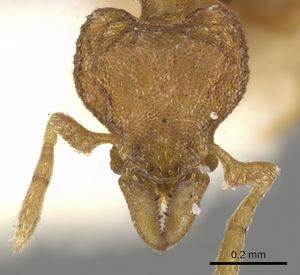Strumigenys ocypete
| Strumigenys ocypete | |
|---|---|

| |
| Scientific classification | |
| Kingdom: | Animalia |
| Phylum: | Arthropoda |
| Class: | Insecta |
| Order: | Hymenoptera |
| Family: | Formicidae |
| Subfamily: | Myrmicinae |
| Tribe: | Attini |
| Genus: | Strumigenys |
| Species: | S. ocypete |
| Binomial name | |
| Strumigenys ocypete (Bolton, 2000) | |
Known from a lowland forest, a worker collected on a log, and rainforest, a worker collected in a litter sample.
Identification
Bolton (2000) - A member of the Strumigenys extemena-group. The largest member of the group yet discovered, and with the most strongly developed cephalic sculpture. Unique features of ocypete include the acute but distinctly irregular crest across the vertex, and the flattened scale-like large hair that projects forward from the sharply angled leading edge of the scape at its widest point.
Keys including this Species
Distribution
Distribution based on Regional Taxon Lists
Indo-Australian Region: Borneo (type locality), Indonesia, Malaysia.
Distribution based on AntMaps
Distribution based on AntWeb specimens
Check data from AntWeb
Countries Occupied
| Number of countries occupied by this species based on AntWiki Regional Taxon Lists. In general, fewer countries occupied indicates a narrower range, while more countries indicates a more widespread species. |

|
Estimated Abundance
| Relative abundance based on number of AntMaps records per species (this species within the purple bar). Fewer records (to the left) indicates a less abundant/encountered species while more records (to the right) indicates more abundant/encountered species. |

|
Biology
Castes
Worker
Images from AntWeb
   
| |
| Holotype of Pyramica ocypete. Worker. Specimen code casent0900141. Photographer Will Ericson, uploaded by California Academy of Sciences. | Owned by NHMUK, London, UK. |
Nomenclature
The following information is derived from Barry Bolton's Online Catalogue of the Ants of the World.
- ocypete. Pyramica ocypete Bolton, 2000: 420, figs. 259, 287 (w.) BORNEO. Combination in Strumigenys: Baroni Urbani & De Andrade, 2007: 125
Unless otherwise noted the text for the remainder of this section is reported from the publication that includes the original description.
Description
Worker
Holotype. TL 2.0, HL 0.48, HW 0.46, CI 96, ML 0.16, MI 33, SL 0.24, SI 52, PW 0.28, AL 0.5l. Leading edge of scape with a pronounced anteriorly projecting angle or elbow near the base, the apex of this angle with a single flat scale-like hair that projects anteriorly. Distal of this hair the leading edge only with minute apically curved spatulate hairs. Mandible mid-dorsally with a short straight low carina that extends forward from the mandible base to just distal of the level of the first large tooth. Dorsum of head with a sharply defined, acute but irregular and somewhat jagged, transverse crest across the highest point of the vertex. Eye minute, of a single ommatidium. Dorsum of head without standing hairs of any form. Clypeus finely granulate and dully shining. Dorsum of head behind clypeus densely reticulate-punctate, the individual punctures sharply defined. Surface also with scattered irregular rugulae, in particular a mid-dorsal rugule runs anteriorly from the midpoint of the crest. Other rugulae run posteriorly toward the occipital margin from the posterior face of the crest. Dorsal alitrunk and petiole without standing hairs but postpetiole with one pair posteriorly and first gastral tergite with a number of short straight erect hairs. Minute hairs on all surfaces of legs subdecumbent to appressed and directed toward the apices of the segments. Pronotum sharply marginate anteriorly and laterally, the margins raised; dorsal surface almost circular and shallowly depressed, shining and with faint vestiges of superficial sculpture. Mesonotum in dorsal view extremely compressed from side to side so that the dorsum is merely a narrow longitudinal blunt ridge. Anterior portion of propodeal dorsum also bilaterally compressed and in line with the preceding mesonotal ridge; in profile the two separated by a shallow concavity in the outline. Mesopleuron mostly smooth and shining but most of metapleuron and side of propodeum finely superficially sculptured rather than smooth. Propodeal declivity with broad lamellae. Petiole node in dorsal view broader than long, with superficial vestiges of punctulate sculpture. Postpetiole broad, unsculptured. Basigastral costulae strongly developed and very obvious, their length in dorsal view about equal to that of the postpetiole disc.
Type Material
Holotype worker, Malaysia: Sarawak, 4th. Division, Gn. Mulu Nat. Pk RGS Expd, Long Pala, 20.ix.1977, lowl. rainfor., on log (B. Bolton) (The Natural History Museum).
References
- Baroni Urbani, C. & De Andrade, M.L. 2007. The ant tribe Dacetini: limits and constituent genera, with descriptions of new species. Annali del Museo Civico di Storia Naturale “G. Doria” 99:1-191.
- Bolton, B. 2000. The ant tribe Dacetini. Memoirs of the American Entomological Institute. 65:1-1028. (page 420, figs. 259, 287 worker described)
References based on Global Ant Biodiversity Informatics
- Pfeiffer M.; Mezger, D.; Hosoishi, S.; Bakhtiar, E. Y.; Kohout, R. J. 2011. The Formicidae of Borneo (Insecta: Hymenoptera): a preliminary species list. Asian Myrmecology 4:9-58

